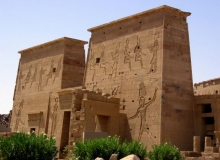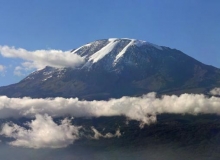
Speak to a specialist
0208 777 4873
0208 777 4873
Places to see: Africa

TEMPLE OF PHILAE
Philae is mentioned by numerous ancient writers, including Strabo, Diodorus, Ptolemy, Seneca, Pliny the Elder. It was, as the plural name indicates, the appellation of two small islands situated in latitude 24° north, just above the First Cataract near Aswan (Ancient Egyptian: Swenet, "Trade;" Ancient Greek: Syene). Groskurd computes the distance between these islands and Aswan at about 61.5 miles (99 km).
Philae proper, although the smaller island, is, from the numerous and picturesque ruins formerly there, the more interesting of the two. Prior to the inundation, it was not more than 1,250 feet (380 m) long and about 400 feet (120 m) broad. It is composed of Syenite stone: its sides are steep and on their summits a lofty wall was built encompassing the island.
Philae, being accounted one of the burying-places of Osiris, was held in high reverence both by the Egyptians to the north and the Nubians (often referred to as Ethiopians in Greek) to the south. It was deemed profane for any but priests to dwell there and was accordingly sequestered and denominated "the Unapproachable". It was reported too that neither birds flew over it nor fish approached its shores. These indeed were the traditions of a remote period; since in the time of the Ptolemies of Egypt, Philae was so much resorted to, partly by pilgrims to the tomb of Osiris, partly by persons on secular errands, that the priests petitioned Ptolemy Physcon (170-117 BC) to prohibit public functionaries at least from coming thither and living at their expense. In the 19th century AD, William John Bankes brought the Philae obelisk on which this petition was engraved to England. When its Egyptian hieroglyphs were compared with those of the Rosetta stone, it threw great light upon the Egyptian consonantal alphabet.
The islands of Philae were not, however, merely sacerdotal abodes; they were the centres of commerce also between Meroë and Memphis. For the rapids of the cataracts were at most seasons impracticable, and the commodities exchanged between Egypt and Nubia were reciprocally landed and re-embarked at Syene and Philae.
The neighbouring granite quarries also attracted a numerous population of miners and stonemasons; and, for the convenience of this traffic, a gallery or road was formed in the rocks along the east bank of the Nile, portions of which are still extant.
Philae also was remarkable for the singular effects of light and shade resulting from its position near the Tropic of Cancer. As the sun approached its northern limit the shadows from the projecting cornices and moldings of the temples sink lower and lower down the plain surfaces of the walls, until, the sun having reached its highest altitude, the vertical walls are overspread with dark shadows, forming a striking contrast with the fierce light which illuminates all surrounding objects.

MOUNT KENYA
At 5199m high, Mount Kenya is Africa's second highest mountain. It offers easy or challenging ascents with superb scenic beauty. To the Kikuyu tribes people it is the home of the Supreme Being: Ngai, a god that resides here. Part of the mountain's fascination is the variation in flora and fauna as the altitude changes. The lower slopes are covered with dry upland forest, the true montane (mountain) forest begins at 2000m is mainly cedar and podo. At 2500m begins a belt of bamboo forest which merges into the upper forest of smaller trees, interspersed with glades. The high altitude heath at the top (3000-3500m) is generally open, dotted with shrubs, African sage, protea and helicrysum. Animals found here are Sunni buck, Mount Kenya mole, shrew, skinks (lizard) and variety of owls. Occasional sightings have been recorded of albino zebra.
ABERDARE NATIONAL PARK
The Aberdare National Park is part of the Aberdare Mountain Range, a fascinating region of Kenya. Aberdares was made famous because it is unique park that Princess Elizabeth spent the night in a unique tree hotel and became Queen upon her father's death. This park is noted for mountain ranges and peaks that soar to around 14,000 ft giving way to deep V-shaped valleys with streams and rivers cascading over spectacular waterfalls - this area is a must for landscape lovers. From its vital catchments area the Aberdare Rainforest feeds the entire local and Nairobi water supply. Game found in this forest are:- Bongo - a rare and elusive forest antelope, eland, serval cats, elephant, buffalo, lion, rhino, leopard, baboon, Black and White Colobus and Sykes monkeys. Rare sightings have also been made of the Golden cat. Bird viewing is incredible with over 250 species recorded including Jackson's Franklin, sparrow hawk, African goshawk, eagles, sunbirds and plovers.

MOUNT KILIMANJARO NATIONAL PARK
Kilimanjaro means Mountain of Light, Mountain of Greatness or Mountain of Caravans. It consists of 3 summits: to the west, the Shira plateau, to the east Mawenzi peak and between the two the snow-capped summit of Kibo which reaches 5,895 meters. There are several ways to reach the top: Marangu route (to the west) is the most popular, Machame (to the west), Umbwe and Mweka (to the south) are more demanding. Those who reach Uhuru point, the actual summit, or Gillman's Point on the lip of the crater, will have earned their climbing certificates and their memories.
The journey up the slope takes you through climatic world tour from the tropic to the artic. The grassy and cultivated lower slopes turn into lush rainforest, inhabited by elusive elephant, leopard, buffalo and antelope. Higher still, heath and moorland, covered with giant heathers, becomes surreal alpine desert and finally, ice, snow and the magnificent beauty of the top of the continent. One should allow a minimum of 4 nights, preferably 5 or even more nights for the climb to increase your acclimatization time and maximize your chances of reaching the summit. Take your time and enjoy the beauty of the mountain.
Subscribe here to our monthly newsletters


